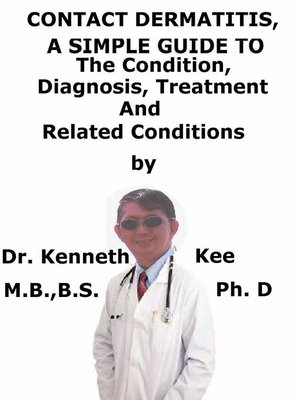Contact Dermatitis, a Simple Guide to the Condition, Diagnosis, Treatment and Related Conditions
ebook
By Kenneth Kee

Sign up to save your library
With an OverDrive account, you can save your favorite libraries for at-a-glance information about availability. Find out more about OverDrive accounts.
Find this title in Libby, the library reading app by OverDrive.



Search for a digital library with this title
Title found at these libraries:
| Library Name | Distance |
|---|---|
| Loading... |
This book describes Contact Dermatitis, Diagnosis and Treatment and Related DiseasesContact Dermatitis is a frequent skin disorder which presents as an erythematous or vesicular rash on face, neck, hands and other areas in contact with external environmental substances.The cause of Contact Dermatitis is related to the exposure of the skin to the external environmental substances, chemicals or plants.There may be a latent interval of days or years between first exposure and development of sensitization.Virtually any substance can cause sensitivity of the epidermis of the skin.Dermatitis is the inflammation of the skin that causes red, itchy skin which may also blister.1. Dermatitis caused by a problem from within the body.Atopic eczema (atopic dermatitis) is a frequent disorder which tends to run in families.Different parts of the skin are likely to flare up with inflammation intermittently.2. Dermatitis caused by a substance from outside the body.This normally causes patches of inflammation on areas of skin which have come into contact with the substance.This is called contact dermatitis.People who gets contact dermatitis1. Nurses (and other health care workers)2. Beauticians3. Bartenders4. Chefs (and others who work with food)5. Florists (and others who work with plants)6. Construction workersThe patient also has a greater risk of forming contact dermatitis if the patient have one of these medical disorders:1. Asthma2. Hay fever3. Atopic dermatitisThe environment also has a part to play.Extreme heat or cold, high humidity, and very dry air make the skin more vulnerable.Causes:Some possible triggers are:1. Metals particularly nickel from bracelet, pendants, neck chains2. Dyes from cosmetics, lipstick, clothes, hair dyes3. Chemicals from perfumes, soaps, shaving cream, antiseptic creams4. Drugs such as penicillin, sulphonamides, tetracycline, neomycin, aspirin, NSAIDs5. Plants such as poison ivy, flowers, pollens6. Animals – the fur from animalsThere are two main types of contact dermatitis1.Irritant contact dermatitis:This type is more frequent.It forms when something irritates the skin2.Allergic contact dermatitisThe patient only requires a small amount of allergen in contact with the skin to cause the rash.Symptoms:1. Vesicular or bubbles in areas most in contact2. Erythrematous or red rashes in areas most in direct contact3. Hives or urticariaDiagnosis:To diagnose this frequent skin disorder, dermatologists:1. Examine the skin, paying close attention to the rash.2. Ask about current and past health issues.3. Ask questions to help them determine what is causing the rashIf the dermatologist believes that the patient have an allergy, patch testing may be advisedPatches with small quantities of substances to which the patient may be allergic will be applied to the skin, normally on the back with review in 2 days for any reactionsTreatmentInitial treatment for contact dermatitisThe main treatment is to remove any offending substance from skin contact.Because the skin may also be sore, itchy and scaly, these may help clear the symptomsMoisturizersTopical steroids-Use mildest firstAntibiotic if infectedOral steroid if neededMedicines such as azathioprine, or cyclosporine.Ultraviolet light exposure with psoralen (PUVA)Long term treatment:Avoid the causeHand careIntermittent use of topical steroidAntihistamineChange jobOther treatments:Oatmeal bathsWet dressingsSystemic contact dermatitis:Some people develop a rash even when they avoid touching the allergenAllergens enter through food, inhalation, even tooth fillingTABLE OF CONTENTIntroductionChapter 1 Contact DermatitisChapter 2 CausesChapter 3 SymptomsChapter 4 DiagnosisChapter 5 TreatmentChapter 6 PrognosisChapter 7 EczemaChapter...







